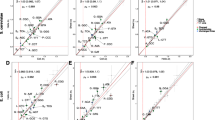Abstract.
Amino acid residues arginine (R) and lysine (K) have similar physicochemical characteristics and are often mutually substituted during evolution without affecting protein function. Statistical examinations on human proteins show that more R than K residues are used in the proximity of R residues, whereas more K than R are used near K residues. This biased use occurs on both a global and a local scale (shorter than ∼100 residues). Even within a given exon, G + C-rich and A + T-rich short DNA segments preferentially encode R and K, respectively. The biased use of R and K on a local scale is also seen in Saccharomyces cerevisiae and Caenorhabdidtis elegans, which lack global-scale mosaic structures with varying GC%, or isochores. Besides R and K, several amino acids are also used with a positive or negative correlation with the local GC% of third codon bases. The local-, or ``within-gene''-, scale heterogeneity of the DNA sequence may influence the sequence of the encoded protein segment.
Similar content being viewed by others
Author information
Authors and Affiliations
Additional information
Received: 2 March 1998 / Accepted: 23 April 1998
Rights and permissions
About this article
Cite this article
Nishizawa, M., Nishizawa, K. Biased Usages of Arginines and Lysines in Proteins Are Correlated with Local-Scale Fluctuations of the G + C Content of DNA Sequences. J Mol Evol 47, 385–393 (1998). https://doi.org/10.1007/PL00006396
Issue Date:
DOI: https://doi.org/10.1007/PL00006396




